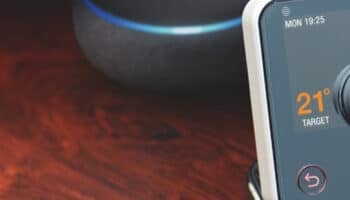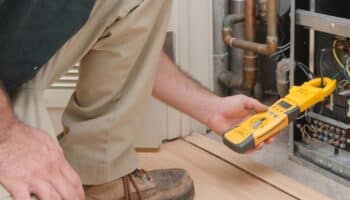We've independently reviewed this article to make sure it's as accurate as we can make it.
To find out more about our article creation and review process, check out our editorial guidelines.
Does the temperature in your home go up and down like a yo-yo?
Then relocating your thermostat may be the key to stabilizing the atmosphere. You’ll find out how to move yours in this article!
Here’s how to move a thermostat:
- Turn off the power to the thermostat at the breakers
- Remove the interface and disconnect the wires
- Remove the back panel from the wall
- Drill a hole in the new location
- Set the back panel
- Pull the wires through the drilled hole
- Connect the wires to the thermostat’s interface
Is the position of your thermostat making the temperature in your home fluctuate?
Then moving the thermostat may just be the solution to the problem. Are you ready to have a more detailed look at the steps mentioned above?
Then let’s dive into the details and solve this for good.
First – Is This Worth It For You?
While it is possible to move a wired-in thermostat, it can be quite an ordeal. Involving a lot of effort, and potentially leaving behind holes in your wall.
A simpler and quicker option would be to get a wireless thermostat. This can be an easier replacement with modern models which can retrofit to your furnace / air conditioning system.
Many modern thermostat models even operate using the temperature sensed by a remote, which you can place in your preferred location.
A recommendation from our HVAC expert is the T10 Honeywell Thermostat.
Step-by-Step Guide to Moving A Thermostat
It’s a cold day out, and it’s just as nippy inside. You turn your thermostat up a couple of degrees then wait 20 minutes. Before long, your living room, which not long ago resembled the North Pole is now as stifling as the Amazon Rainforest.
Are you having trouble adjusting the temperature in your home? Then moving your thermostat might be all you need to do to enjoy regulated cooling and heating.
Coming up is a list of all the steps you will need to move your thermostat. But to get the ball rolling, here’s a list of the tools that are good to have on hand for the job:
- Small pliers
- A screwdriver
- A drill
- A wire fishing tool
Step 0: Survey
Before we get started, it’s important to plan out your intentions with this DIY project. Figure out where you want to locate the thermostat, and try to gauge whether you can pull new wires to the location while still being connected to the air handler or furnace.
Step 1: Turn off the Power
You should turn off the power at the circuit breakers. Make sure you do this before you attempt to uninstall the thermostat. This will ensure that the area is safe for you to work on. Once you’ve assured the power is off, continue to steps 2 and 3.
Step 2: Uninstall the Thermostat
To uninstall the thermostat, remove the interface from the back panel. You may need a screwdriver for this. Make a note of or take a picture of how the wires are connected so that you can reconnect them later.
Then disconnect the wires. You can disconnect the wires by unraveling them with your fingers or with a small pair of pliers.
Then use a screwdriver to remove the back panel from its housing on the wall.
** Include a photo here of someone with a screwdriver to a thermostat. https://sp.depositphotos.com/serie/161151986.html?qview=162140268 **
Step 3: Reinstall the Thermostat
Choose a suitable location for the new thermostat. Then use a drill to make holes for the new back panel housing. Set the back panel housing over the holes. Use a wire fishing tool to pull the wires through the holes in the back panel.
Refer to your notes or photo of the old wire locations. Connect the interface to the wires.
Once you have completed the steps mentioned above, turn the electricity back on. You can now enjoy refreshingly cool summers and toasty warm winters. That’s right, without having to constantly fight with the thermostat!
Where to Move a Thermostat to Enjoy Better Heating/Cooling
Moving your thermostat may be the solution to your cooling and heating problem. But that’s only true if you move the thermostat to the right place. Having your thermostat in the wrong place can cause issues such as:
- Uncomfortably hot or cold temperatures
- A heating or cooling system that is constantly cycling on and off
- Sky-high utility bills

So where shouldn’t you keep your thermostat? Here is a list of places that definitely won’t make a good home for your thermostat:
| Thermostat Location | Effect on Your Heating and Cooling System |
| Near Doors and Windows | The draft from doors and windows cool the air around the thermostat. This could make the thermostat raise the temperature of the heating unnecessarily. The doors in a house are constantly being opened and closed. This could make the thermostat think the home is cooler or warmer than it is. |
| In Direct Sunlight | Direct sunlight on your thermostat could trick it into thinking that the house is too hot. This may cause the thermostat to cycle on the heating when it is not needed. |
| Near the Bathroom Door | The areas near the bathroom door are subject to steam and humidity from the bathroom. The steam could make the cooling system cycle on or it could lower the level of the heating. |
| On Exterior Walls | Your home’s exterior walls are usually cooler than the others in the winter. This could make your thermostat conclude that your home is cooler than it actually is. Your exterior walls (especially west-facing ones) are usually hotter than interior walls. This is most definitely the case in the summer. The heat of the walls on the thermostat could needlessly make the air conditioning cycle on. |
| In Scarcely Used Rooms or in Hallways | Thermostats placed in scarcely used rooms only give readings for closed spaces. These may not accurately portray the temperature in other, larger rooms.The hallway will not give an accurate reading of a living space. Hallways don’t usually have many heating and cooling devices. This could make your thermostat cycle your heating or cooling on high to reach a perfect temperature in the hallway. |
| Above Air Vents | Thermostats placed above air vents are exposed to draft. This leads to ghost readings that heat up your house more than necessary. |
| In the Kitchen | The kitchen is one of the hottest rooms in the house. If you leave your thermostat in the kitchen it will detect high temperatures. This could make your thermostat think that the house is too warm and cool it down. |
| Above a Heating or Cooling System | Keeping the thermostat near a radiator could make it conclude that the house is hotter than it is.Keeping the thermostat near an air conditioning could make it think that the house is cooler than it is. |
You’ve come to the right conclusion. The thermostat is fussier than you had ever imagined. So, where is the ideal location for your thermostat?
Your thermostat should be:
- Far away from doors and windows
- Out of direct sunlight
- Far away from the bathroom
- On an interior wall in the center of the home
- In the most used room in the house
- Out of reach of an air vent
- Far away from the kitchen
- Far away from a radiator or the flow of an air conditioning unit

Most homeowners place their thermostat on the inside wall of the living room. It’s also common to see one in other large rooms that the family spends most of their time in. They make sure it isn’t obstructed by bookshelves or other big items of furniture. Big items of furniture would block the sensors. This in turn helps the thermostat give more accurate readings.
The Benefits of Moving a Thermostat
Moving a thermostat isn’t a long job, but it is a fiddly one. So, is it really worthwhile to move a thermostat? What are the benefits of doing so? Here are just two of them:
- Regulated temperatures in your home. By moving your thermostat, it could work more efficiently. The sensors could detect temperatures better. They could adjust themselves without you having to worry about it.
- Lower energy bills. If your thermostat is in the right place, your heating and cooling systems should cycle on and off less. If they are not running as often, you should see a drop in your electric bill. Heating and cooling equipment make up on average 40% of your electric bill. You’ve guessed it, this could be a massive saving for you! Time for a vacation in the Caribbean I hear?
Conclusion
There is nothing more frustrating (and pricey) than a thermostat that keeps cycling on and off. Are temperatures skyrocketing, plummeting, and zigzagging in your home? Then you may need to move your thermostat. I’m sure this article has shown you the best location for your thermostat and how to move it.
The decision to move a thermostat rests on the conclusion that the present location isn’t a good place that represents the ambient temperature of the space.
In short, the thermostats sensor is in the wrong place.
Again we recommend considering a thermostat with a wireless remote sensor. Many thermostats already have the feature, it may just need to be turned on. Or you could buy a new thermostat replacing the old one, and then put the sensor in a better location.
If this article has helped you, then why not check out some of our other articles and free guides? You could even sign up to our email list!
Have a great day!
-Craig







